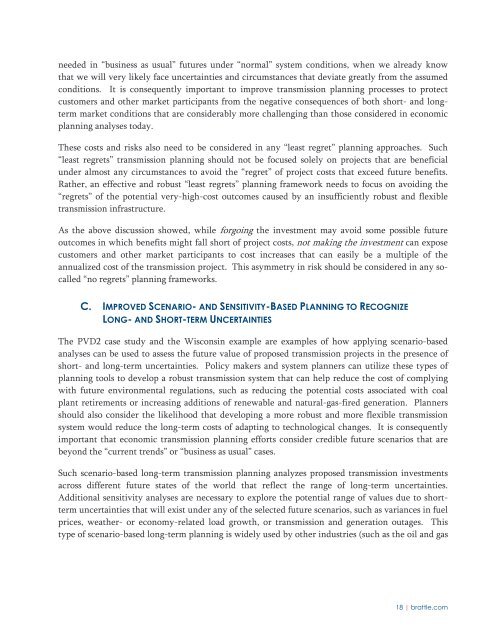THE BRATTLE GROUP
pvrbYG
pvrbYG
You also want an ePaper? Increase the reach of your titles
YUMPU automatically turns print PDFs into web optimized ePapers that Google loves.
needed in “business as usual” futures under “normal” system conditions, when we already know<br />
that we will very likely face uncertainties and circumstances that deviate greatly from the assumed<br />
conditions. It is consequently important to improve transmission planning processes to protect<br />
customers and other market participants from the negative consequences of both short- and longterm<br />
market conditions that are considerably more challenging than those considered in economic<br />
planning analyses today.<br />
These costs and risks also need to be considered in any “least regret” planning approaches. Such<br />
“least regrets” transmission planning should not be focused solely on projects that are beneficial<br />
under almost any circumstances to avoid the “regret” of project costs that exceed future benefits.<br />
Rather, an effective and robust “least regrets” planning framework needs to focus on avoiding the<br />
“regrets” of the potential very-high-cost outcomes caused by an insufficiently robust and flexible<br />
transmission infrastructure.<br />
As the above discussion showed, while forgoing the investment may avoid some possible future<br />
outcomes in which benefits might fall short of project costs, not making the investment can expose<br />
customers and other market participants to cost increases that can easily be a multiple of the<br />
annualized cost of the transmission project. This asymmetry in risk should be considered in any socalled<br />
“no regrets” planning frameworks.<br />
C. IMPROVED SCENARIO- AND SENSITIVITY-BASED PLANNING TO RECOGNIZE<br />
LONG- AND SHORT-TERM UNCERTAINTIES<br />
The PVD2 case study and the Wisconsin example are examples of how applying scenario-based<br />
analyses can be used to assess the future value of proposed transmission projects in the presence of<br />
short- and long-term uncertainties. Policy makers and system planners can utilize these types of<br />
planning tools to develop a robust transmission system that can help reduce the cost of complying<br />
with future environmental regulations, such as reducing the potential costs associated with coal<br />
plant retirements or increasing additions of renewable and natural-gas-fired generation. Planners<br />
should also consider the likelihood that developing a more robust and more flexible transmission<br />
system would reduce the long-term costs of adapting to technological changes. It is consequently<br />
important that economic transmission planning efforts consider credible future scenarios that are<br />
beyond the “current trends” or “business as usual” cases.<br />
Such scenario-based long-term transmission planning analyzes proposed transmission investments<br />
across different future states of the world that reflect the range of long-term uncertainties.<br />
Additional sensitivity analyses are necessary to explore the potential range of values due to shortterm<br />
uncertainties that will exist under any of the selected future scenarios, such as variances in fuel<br />
prices, weather- or economy-related load growth, or transmission and generation outages. This<br />
type of scenario-based long-term planning is widely used by other industries (such as the oil and gas<br />
18 | brattle.com


